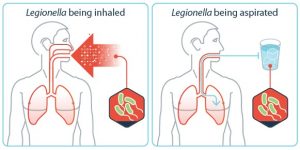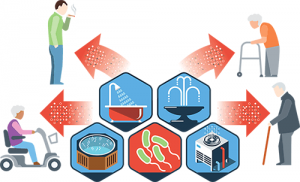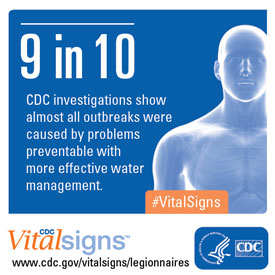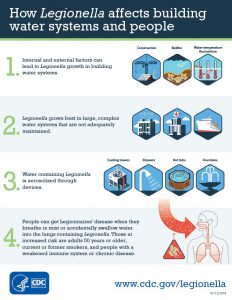Legionellosis is caused by bacteria called Legionella. The disease has two different forms. Legionnaires’ disease is the more severe form of infection that causes pneumonia. Pontiac fever is caused by the same bacteria, but is a milder, self-limiting, acute illness without pneumonia.
The disease got its name after a group of people attending a convention of the American Legion in Philadelphia in 1976 developed pneumonia. While the Legionella bacteria were around before 1976, scientists had never been able to find it in an ill person’s lungs before that time.

Link to partner’s website:
VDH-OEPI Legionellosis Fact Sheet
VDH-OEPI Legionellosis Information
VDH-ODW Information for Consumers and Building Owners
VDH-ODW Information for Waterworks Owners
CDC - For Building Owners & Operators Legionnaires' Disease and Pontiac Fever
Legionella bacteria have many species and serogroups, the most important of which is Legionella pneumophila. Leginonellae are commonly found in water and soil. Within water, they can live in biofilms or inside protozoa such as free-living amoeba. Biofilms and live within protozoa protects them from harmful environmental conditions.
Symptoms of Legionnares’ disease arise 2 to 10 days after exposure to the organism. Symptoms include fever, cough, shortness of breath etc.
Cases of legionellosis are more common in individuals who are 50 years of age or older, smokers, people with chronic lung disease, and individuals with weakened immune systems.
Legionella is naturally found in water and it is usually spread through water droplets in the air. One can get infected with Legionella when one breathes in contaminated water droplets or accidentally sucks (aspirates) water into the lungs.

There have been Outbreaks from exposure to aerosols generated form shower heads, cooling towers, mist machined, and other aerosols. Legionella grow best under a temperature of 40o C to 50o C and they have been known to survive in water chlorination. Legionella can colonize the water systems of hospitals and large buildings.

- Hot tubs that are not cleaned and disinfected properly
- Cooling towers
- Plumbing systems
- Hot water tanks and heaters
- Decorative fountains
Cases of Legionaries’ disease have tripled in Virginia from 2005 to 2017. This is probably due to increased awareness, surveillance and testing for the disease. The
disease is more common in men than women and the incidence is higher between the months of May and October. Outbreaks of Legionaries’ disease in Virginia have been associated with Nursing Homes, Private Homes and Gyms and Spas.
- To improve the understanding among state and local health department staff regarding maintenance strategies and primary prevention of Legionnaires’ disease.
- To foster a knowledge base, upon which we can develop maintenance strategies and measure its efficacy.
- To identify existing barriers to integrating maintenance strategies within current regulatory functions (i.e. building permits, facility inspections, etc.).
- To assess water maintenance plan for vulnerabilities
Contact your local Health Department or VDH-OEPI Divison of Surveillance & Investigation Legionellosis site for more information about Legionella.






